|
|
|
Sort Order |
|
|
|
Items / Page
|
|
|
|
|
|
|
| Srl | Item |
| 1 |
ID:
178213


|
|
|
|
|
| Summary/Abstract |
The Russian-led Eurasian Economic Union (EAEU) is a key partner in China’s Belt, and Road Initiative (BRI), since it comprises the majority of territories which the BRI’s overland route, the Silk Road Economic Belt, needs to traverse as it crosses Central Asia on the way to Europe. The goal of this article is to explore the BRI in the context of BRI–EAEU coordination. The first part of the analysis focusses on the ways the Eurasian Economic Commission delineates the “Greater Eurasian Partnership” and counterposes it against China and the BRI. Then, the article compares two sets of interpretations of the BRI and “Greater Eurasian Partnership” obtained from interviews with elites in Kazakhstan and Russia. The interviews indicate that the BRI has had a much more forceful impact on local elites than Russia’s idea of “Greater Eurasian Partnership.”
|
|
|
|
|
|
|
|
|
|
|
|
|
|
|
|
| 2 |
ID:
178215
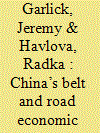

|
|
|
|
|
| Summary/Abstract |
Drawing on the literature on strategic hedging and adapting it to China’s use of economic diplomacy in the service of comprehensive national security goals within the regionalised foreign policy approach of the Belt and Road Initiative (BRI), we examine China’s approach to securing and expanding its interests in the Persian Gulf. To implement the trade and infrastructure connectivity goals of the BRI and to secure the continued flow of diversified energy supplies, China needs to boost relations with both regional powerhouses, Iran and Saudi Arabia, without alienating either of them or the regional hegemon, the United States. The resulting strategy of strategic hedging is based in the Chinese approach to economic diplomacy, which utilises Chinese commercial actors in the service of national strategic objectives. Relations require careful and ongoing management if China is to achieve outcomes which benefit all sides while avoiding becoming entangled in the region’s intractable geopolitical problems.
|
|
|
|
|
|
|
|
|
|
|
|
|
|
|
|
| 3 |
ID:
168915
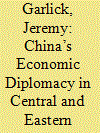

|
|
|
|
|
| Summary/Abstract |
Since China launched the 16 + 1 forum for meetings with Central and Eastern European (CEE) countries in 2012, European observers have struggled to understand the Chinese approach. In contrast to its oft-repeated claim of ‘win–win’ cooperation, some believe China is pursuing an assertive strategy of ‘divide and conquer’ designed to benefit China at Europe’s expense. China’s economic diplomacy in CEE is examined through the critical lens of Holslag’s ‘offensive mercantilism’ framework, finding it useful for assessing empirical aspects of China’s approach to CEE, but failing to find evidence for the assertion that China’s economic diplomacy is divisive and bad for Europe.
|
|
|
|
|
|
|
|
|
|
|
|
|
|
|
|
| 4 |
ID:
191876
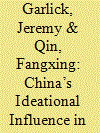

|
|
|
|
|
| Summary/Abstract |
Chinese and European scholarly debates on China’s relations with Central and Eastern Europe (CEE) have steadily heated up since the introduction of the 16/17 + 1 cooperation mechanism in 2012. However, they have tended to take place in discrete linguistic and academic bubbles. This article has three aims: first, to introduce Chinese scholarly debates on China-CEE cooperation to an Anglophone readership; second, to conduct a critical assessment of Chinese and European scholars’ inclusions and omissions; and third, to compare the narratives presented by Chinese scholars concerning China-CEE cooperation with European scholars’ interpretations. The content analysis demonstrates that Chinese scholars under-emphasize the influence-forming and ideational aspects of the platform, while European scholars insufficiently analyze the extent to which the 16/17 + 1ʹs characteristics are shared with other Chinese regional cooperation platforms.
|
|
|
|
|
|
|
|
|
|
|
|
|
|
|
|
| 5 |
ID:
169133
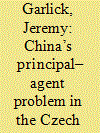

|
|
|
|
|
| Summary/Abstract |
Although it appears that China’s state capitalism model means that state-owned and private companies are utilised in the service of foreign policy goals such as international investments under the umbrella of the Belt and Road Initiative (BRI), the reality is more complex. The behaviour and interests of Chinese commercial actors do not always correspond with the stated aims and strategy of government officials. The article examines Chinese economic diplomacy in the Czech Republic from 2015 to 2018, assessing the extent to which the private company CEFC China Energy acted as an agent of the Chinese state as part of a coordinated strategy designed to increase Chinese economic and political influence via the use of economic incentives. CEFC was at the forefront of Chinese investments in the Czech Republic during this period but CITIC, a Chinese state-owned enterprise (SOE), took over these in May 2018 while the head of CEFC was reportedly being detained in China. The research is theorised in terms of the principal–agent problem, which posits that conflicts of interest and asymmetries of information affect coordination between principals (such as Chinese leaders) and agents (such as private companies). Since the case study reveals conflicts of interest between principals and agents in Chinese state-led economic diplomacy in the Czech Republic, it has implications for understanding the characteristics and practical implications of BRI-framed investment drives in the remainder of the Central and Eastern Europe region.
|
|
|
|
|
|
|
|
|
|
|
|
|
|
|
|
| 6 |
ID:
190481
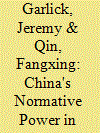

|
|
|
|
|
| Summary/Abstract |
Normative power China (NPC) has characteristics distinct from Manners’ conception of normative power Europe (NPE). While NPE attempts to establish rules for interaction, NPC introduces practices to be co-constituted via regional platforms through a process of ‘earned recognition’. In Central and Eastern Europe (CEE), NPC’s regionalising ‘group cooperation diplomacy’ has taken the form of the ‘16/17 + 1’ cooperation framework. Using normative power theory, the article assesses, via a critical discourse analysis of speeches and interviews, how and why China’s attempts to shape practices, earn recognition and create a community of practice in CEE have met with—at best—only limited success.
|
|
|
|
|
|
|
|
|
|
|
|
|
|
|
|
| 7 |
ID:
159912
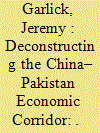

|
|
|
|
|
| Summary/Abstract |
Intense interest in the China–Pakistan Economic Corridor (CPEC) was stimulated when US$46 billion of investment agreements were signed in April 2015, a sum which two years later increased to US$62 billion. A major focus of CPEC is on developing overland transportation and pipeline links from the port of Gwadar to the Chinese province of Xinjiang as a land-based alternative to the maritime ‘chokepoint’ of the Straits of Malacca. This article assesses the viability of pipelines connecting China to the Indian Ocean through Pakistan via a close analysis of evidence obtained from both primary and secondary sources. It concludes that the overland connection is beset with difficulties because of geographical, economic and security problems, and that China’s long-term motivations for maintaining a presence in Pakistan are likely to be chiefly geopolitical rather than geo-economic. In fact, China’s primary aim with CPEC and other investments is to hedge against India by establishing a physical presence in the Indian Ocean Region (IOR), a strategy which is herein referred to as geo-positional balancing.
|
|
|
|
|
|
|
|
|
|
|
|
|
|
|
|
| 8 |
ID:
158042
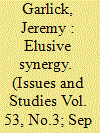

|
|
|
|
|
| Summary/Abstract |
In 2012, China and the European Union (EU) issued a joint declaration on energy security. It is unclear, however, what progress has been made since then in terms of applying the goals of the declaration. This paper sets out to assess the present state of China and the EU’s energy security, the potential for future cooperation, and the obstacles which stand in the way. The analysis assesses the extent to which the two actors can work together on improving energy infrastructure, diversifying supplies, and developing renewable and nuclear energy, possibly by finding synergies between China’s Belt and Road Initiative and the EU’s Juncker Plan. It also includes a re-examination of the concept of energy security to take account of the urgency of addressing the collapse of the global environment. Overall, the analysis suggests that although due to geographical and other constraints there may be limited opportunity for cooperation between the EU and China on securing oil and gas supplies, there are both scope and a pressing need for joint action in the field of renewable energy.
|
|
|
|
|
|
|
|
|
|
|
|
|
|
|
|
| 9 |
ID:
153116


|
|
|
|
|
| Summary/Abstract |
China’s ‘One Belt, One Road’ (OBOR) initiative is a grand plan to connect Asia, Europe and East Africa
economically. However, from India’s point of view, China’s attempt at what it describes as geo-economic
expansion appears as a geopolitical threat because of China’s activity in the Indian Ocean Region (IOR).
This essay assesses the extent to which OBOR is (i) realistic and achievable, (ii) a genuine threat to India
and (iii) amenable to possible Indian involvement. It concludes that India should continue to be wary of
its neighbour in national security terms, but has no option but to cooperate with China economically by
participating in OBOR if it seriously wishes to increase economic growth and bring the ‘Make in India’ and
Sagarmala projects to fruition. In particular, India should seriously consider allowing Chinese companies
to develop one or more Indian ports with associated infrastructure and manufacturing
|
|
|
|
|
|
|
|
|
|
|
|
|
|
|
|
| 10 |
ID:
148509
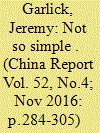

|
|
|
|
|
| Summary/Abstract |
China’s rise to the status of a global power is a very complex phenomenon. Yet students of international relations (IR) are taught that a good theory should be ‘parsimonious’, meaning that it should explain a lot with a little. In relation to China’s rise, the problem with theoretical parsimony may be not what it includes but what it leaves out. This article argues that lack of explanatory breadth and depth in connection with China’s IRs demonstrates a shortcoming in mainstream IR theories such as neorealism, offensive realism and constructivism. A candidate for an IR theory which explains more with more is complexity theory (CT), which utilises a conceptual toolkit including non-linearity, feedback effects, emergent properties and complex adaptive systems. CT’s toolkit, already used in the natural sciences, seems a good candidate to explain the hard-to-predict phenomena that emerge in the international sphere, but has not yet been developed into a clear theoretical lens in IR. In this article, the rise of China is analysed through the lenses of three mainstream theories and CT in order to assess the strengths and shortcomings of each approach and to suggest how CT’s ‘conceptual toolkit’ might be utilised to flesh out existing IR theories in order to explain China’s rise more fully.
|
|
|
|
|
|
|
|
|
|
|
|
|
|
|
|
|
|
|
|
|